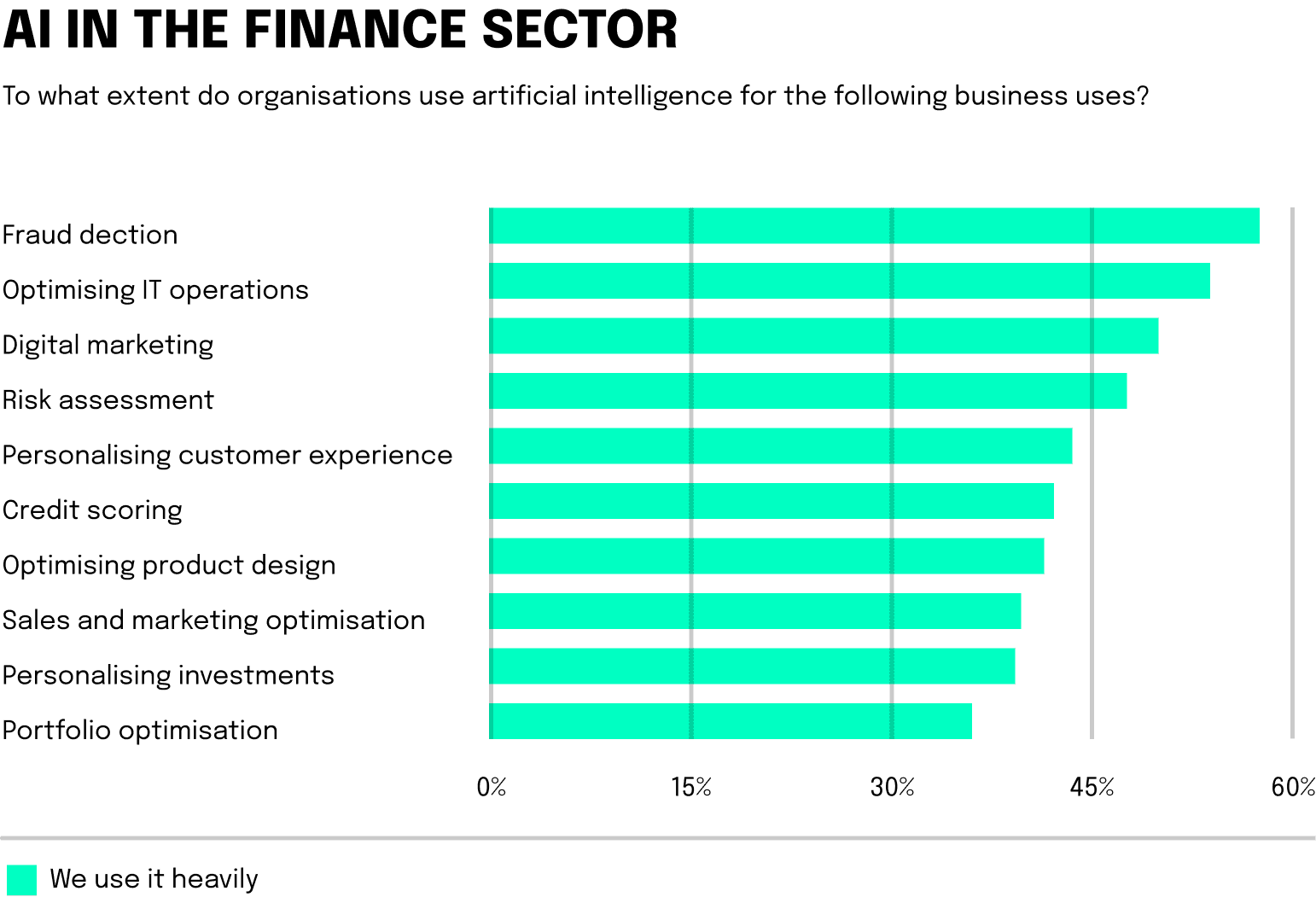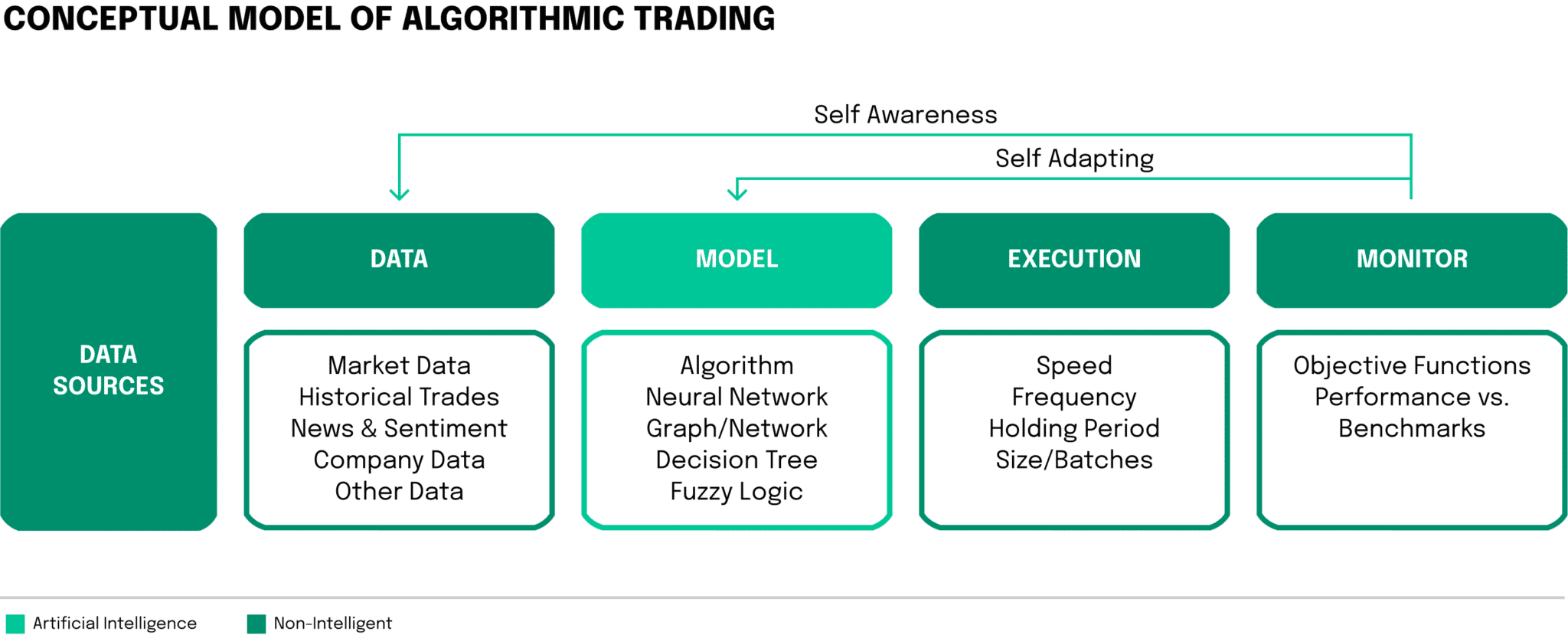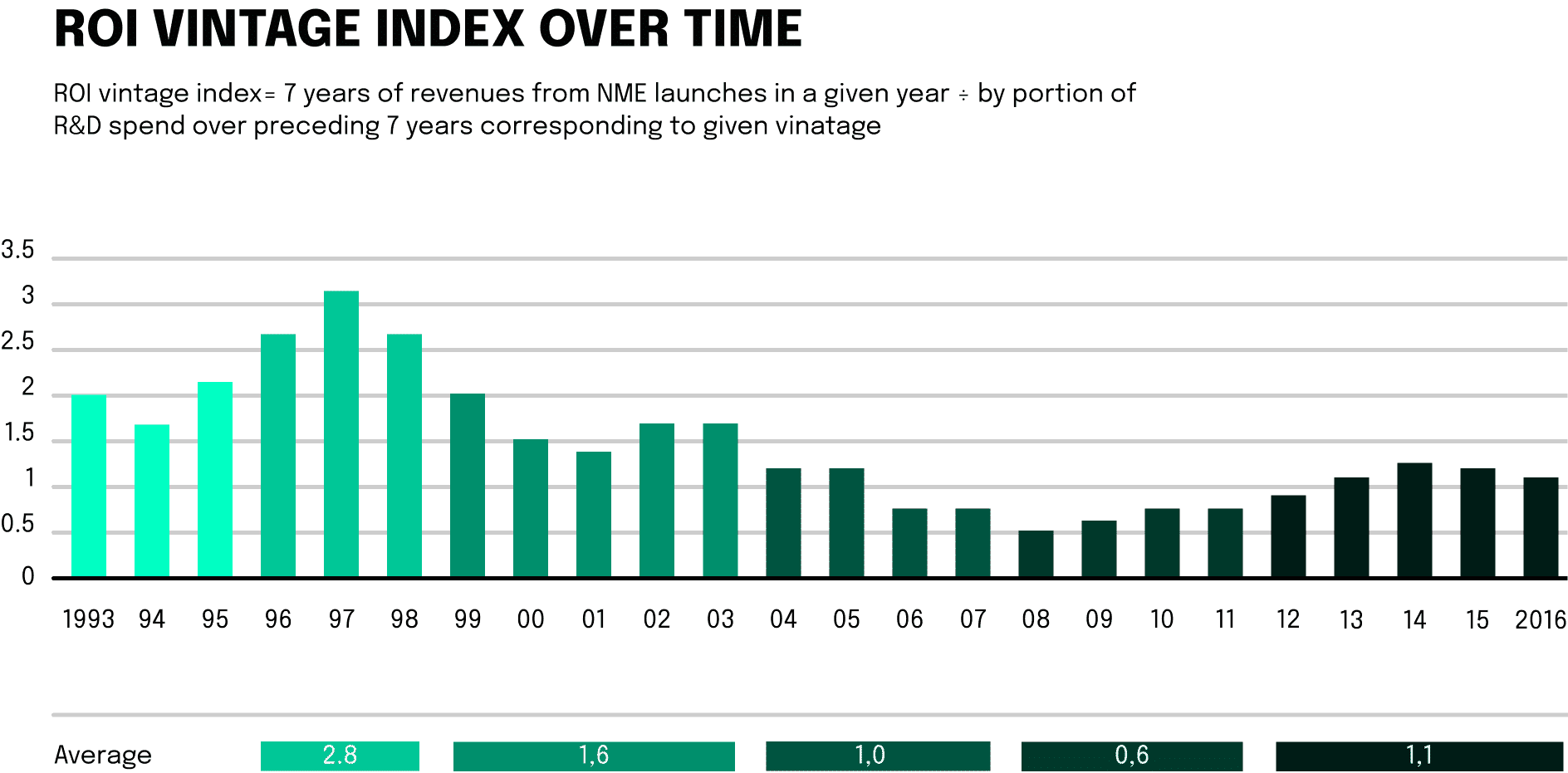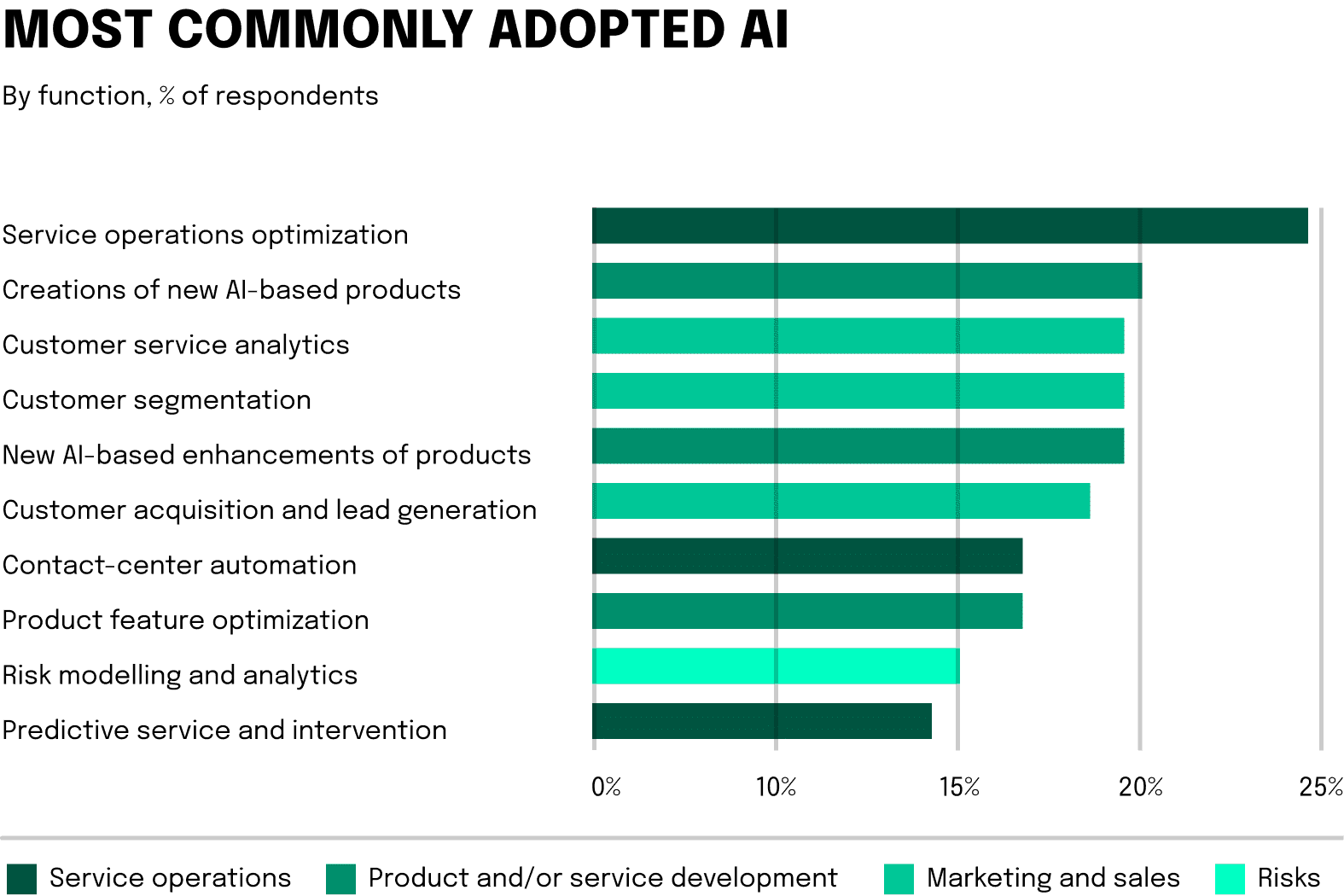23 min reading time
The impact of AI on our working world
Artificial Intelligence (AI) is not just a buzzword; it might be a powerful force that’s altering the fundamentals of how we operate in our professional lives. Our article takes you on a journey to explore the positive influence of AI within the professional world, particularly its potential impacts within the finance and creative sectors.
But, the AI influence isn’t restricted to these sectors alone. Our article delves into the broader benefits that AI could bring to the table – the way it supercharges human efficiency and productivity, the authority it lends to decision-making through insightful data analysis, and the innovation opportunities it opens up.
The hype is real! Between 2017 and today, the average number of AI capabilities that financial organizations use has also doubled, with natural-language generation and computer vision among the most commonly deployed capabilities. The top use case for AI has remained stable, with optimization of service operations taking the top spot each of the past four years. The level of investment in AI has increased along with its adoption. Five years ago, 40% of respondents at organizations using AI reported that more than 5% of their digital budgets went to AI. Now, more than half of the respondents report that level of investment. 63% of respondents expect their organizations’ investment in AI to increase over the next three years.
But are there more use cases possible? Let’s dive deeper into the positive aspects of AI for the financial industry.
AI in the finance sector
There’s a potent transformation occurring within the world of finance, one that’s fueled by the game-changing powers of Artificial Intelligence. From start-ups to global giants, financial institutions are now tapping into AI’s vast potential, with machine learning algorithms and AI models paving the way for smoother operations, fewer errors, and highly tailored client experiences. One interesting fact is that many financial institutions “make risk, capital allocation and underwriting decisions, based on as little as 10% of the data available to them,” says Dr. Lewis Z. Liu, CEO and co-founder of Eigen Technologies. By leveraging AI, financial institutions are better equipped to really transform the decision-making process to be more accurate, efficient, and successful.
A study by the Economist clearly highlights already existing use cases for AI in the finance industry, which can be found in the following graphic:

We are going to analyze some current use cases, whilst also going more into depth about the planned future use cases for AI in the Finance industry.
Current AI use cases in the finance industry
One area experiencing the dramatic impact of AI is automation. Repetitive and time-consuming tasks, such as data input, compliance reporting, and invoice processing, are now within the domain of Robotic Process Automation (RPA), significantly enhanced with AI. The result? Streamlined operations, a steep decrease in manual errors, more efficiency in digital marketing, and increased overall efficiency of operational work in the finance industry. Further, AI is now stepping into customer service roles, with AI-enabled chatbots and virtual assistants addressing customer queries and offering basic advisory services, all the while freeing up human personnel for higher-level tasks.
When you look at risk analysis, AI’s influence is remarkable. Financial institutions are now harnessing advanced machine learning models to delve deep into big data, uncovering patterns, correlations, and trends that human analysis might miss. With AI, predictive risk modeling becomes a reality, enabling proactive risk management and more informed investment decisions backed by factual data.
Financial fraud has been a long-standing challenge in this sector, and AI has stepped in as a potent solution here as well. AI systems, fed with large datasets, learn to distinguish regular transaction patterns and can pick up on irregularities that might point to fraudulent activities. With their continuous learning capabilities, these AI models are becoming increasingly adept at detecting, alerting, and even preventing instances of fraud, thereby bolstering the security quotient for financial institutions and their customers alike.
The sphere of algorithmic trading has also been transformed by AI. Algorithmic trading is the use of computer algorithms to automatically make trading decisions, submit orders, and manage those orders after submission. Here, AI models are deployed to pore over market data, spot trading opportunities, and execute trades with lightning speed and pinpoint accuracy. As AI processes and analyzes huge volumes of data in real-time, it leaves human traders in the dust, responding to market fluctuations instantaneously, potentially yielding higher profits and effectively managing risks. To even better understand how algorithmic trading works and where AI will help, please take a look at the following infographic:

The future of AI in the finance industry
- Personalized Investments: AI’s analytical capabilities can be harnessed to understand a client’s financial circumstances, risk appetite, and investment objectives, which allows for the creation of customized investment advice. This could involve proposing certain equities, bonds, mutual funds, or other investment types that best fit the client’s profile. Moreover, these systems have the ability to adapt their recommendations as a client’s financial situation or market conditions change.
- Portfolio Optimization: AI can be a powerful tool in perfecting a client’s investment portfolio. Through examining market patterns, historical data, and the client’s investment preferences, AI can provide suggestions for portfolio adjustments aimed at enhancing returns and mitigating risk. This could entail advising on the ideal asset allocation or indicating the optimal timing to purchase or sell specific assets.
- Automated Investment Management: Known as robo-advisors, these AI-driven platforms can autonomously handle a client’s investments in alignment with their financial objectives and risk comfort level. They can conduct trades, rebalance portfolios, and carry out other investment management tasks without the need for human interaction, offering an affordable and accessible solution for investment management.
- Predictive Analysis: AI can forecast potential market trends based on historical data and current market conditions, assisting investors in making informed decisions. For example, it can predict the trajectory of stock prices, identify potential market bubbles, or anticipate economic slumps. This predictive capacity can be especially beneficial for investors who actively trade.
The potential benefit of AI for the financial industry
We already covered that the share of players in the financial industry willing to invest in AI is increasing heavily! But what do they expect in return? Buckle up, because the numbers are mind-blowing!
The potential implications of AI in the finance realm are profound. The insurance sector is gearing up for a possible decrease of up to 35% in operational costs, thanks to the efficiency of AI technology. These savings can subsequently enhance service quality and offer customers more innovative products.
Furthermore, it’s striking to note that financial firms already leveraging AI are enjoying exceptional growth – they’re outpacing competitors with an average growth surge of 35%. This correlation underscores AI as a strategic key to unlock growth and stay ahead in an increasingly competitive marketplace.
When we cast our gaze towards lending, it’s evident that AI’s role is growing steadily. Projections indicate that, by 2025, AI could be integral to underwriting a quarter of all loans globally. This trend is set to fundamentally reshape the lending sector, with AI playing a significant role.
Customer service operations in finance are also primed for a major AI-led transformation. Predictions for 2025 indicate that AI will be entrusted with managing a staggering 26 trillion minutes of customer service interactions. This development implies a more streamlined and enhanced user experience for customers.
In essence, as we chart the path forward for finance, it’s hard to overlook the transformative power of AI. It is poised to drive down costs, accelerate growth, revolutionize lending, and revamp customer service. Embracing this technology is no longer an option but an imperative for any financial firm aspiring to lead the pack in the future.
Creativity enhanced: AI in the creative industry
In the realm of the creative industry, artificial intelligence is not merely a tool; it’s a collaborative partner, a co-creator. Its impact extends from media production and visual arts to music composition, revealing fresh possibilities that are pushing the boundaries of creativity.
Human-AI collaboration in the creative industry
One of the most fascinating areas of AI application in the creative sector is Human-AI Creativity. AI isn’t just a passive instrument in the creative process. It’s an active collaborator that contributes to idea generation and expands the horizons of human creativity. AI algorithms can provide novel suggestions based on patterns and insights derived from vast datasets, prompting artists to explore avenues they might not have considered otherwise.
AI’s influence is increasingly apparent in Human-AI Co-Creations. Innovations like text-to-speech, text-to-video, and text-to-image are reshaping content creation. Text-to-speech technologies, powered by AI, are enabling the creation of realistic speech for voice overs and virtual assistants, providing more human-like interactions. In text-to-video and text-to-image conversions, AI algorithms interpret the text and generate corresponding visual content. This ability is profoundly transforming sectors like advertising, where marketers can convert engaging copy into compelling visuals automatically.
But perhaps the most significant contribution of AI lies in its ability to stimulate innovation and ideation in artistry. AI can analyze an artist’s past work, understand stylistic nuances, and suggest innovative ideas for future creations. This predictive ability of AI helps artists push the boundaries of their creativity, fostering the creation of unique and revolutionary works of art.
AI’s role in the creative industry is evolving from being a tool to an enabler, a catalyst, and even a co-creator. By merging human creativity with AI’s computational power, the creative industry is entering a new era of innovation and unprecedented possibilities. The future of creativity is here, and it’s powered by AI.
AI as the creative mind
AI has demonstrated its potential as a creator of original artistic and cultural content in various fields, including visual arts and music composition. According to Margaret Boden, AI programs showcase their creativity by producing novel works, sometimes even surprising humans with their creations.
Several AI models have been recognized for their groundbreaking contributions in the realm of art. An example is the “Portrait of Edmond Belamy,” an AI-generated artwork created by a Generative Adversarial Network (GAN). This AI was fed 15,000 portrait images ranging from the 14th to the 20th century, subsequently creating original images that it thought were human-made. The artwork was later sold for a whopping US$432,500 at a Christie’s auction in 2018.
Another AI model, AICAN, was designed by the Art & AI Lab at Rutgers University. This creative adversarial network (CAN) was trained on 80,000 images from five centuries of Western art history. Unlike the GAN, it was programmed to favor choices that deviated from copying or repeating the art it was exposed to. The result is a wide range of novel artworks that were surprising in terms of style and creativity.
Simultaneously, AI’s impact on the creative process is challenging our understanding of human creativity. Notions of autonomy, motivation, emotion, intention, and consciousness, traditionally attributed solely to human creative labor, are being reevaluated in light of AI’s capabilities.
Augmenting human potential: Efficiency and productivity
AI is becoming the linchpin of a transformation that is redefining our approach to work. By effectively leveraging human creativity and the computational prowess of AI, we are moving towards a future where the boundaries of efficiency and productivity are continually expanded.
The capacity of AI to take over and streamline complex tasks, traditionally requiring substantial human time and effort, is astounding. Today’s businesses utilize AI-driven tools to automate various routine administrative activities, including scheduling meetings or sorting emails. Such automation liberates employees from mundane tasks and allows them to focus on more strategic, value-adding endeavors.
But AI’s potential isn’t limited to task automation. It has proven itself to be an invaluable partner in decision-making processes. With its ability to analyze enormous datasets at lightning speeds, AI provides crucial insights and predictive analytics. This capability enables businesses to identify market trends, predict customer behavior, and make informed, data-driven decisions, all of which boost operational efficiency and strategic planning.
Additionally, AI offers the prospect of optimizing resource allocation to unprecedented levels. A case in point is the use of AI in supply chain management, where it can ensure just-in-time logistics and maintain optimal inventory levels, thereby reducing waste and inefficiency. Through AI, businesses can achieve peak resource utilization, leading to substantial cost reductions and environmental advantages.
Moreover, AI enhances productivity by promoting an environment of continuous learning and improvement. AI can help L&D practitioners quickly develop personalized learning experiences, tailored to the individual needs of each team or individual. With the correct amount of input information entered in a prompt, an extremely individualized learning journey can be outlined in seconds, with robust learning material developed with a few more follow-up prompts. AI will soon be able to provide virtual coaching on-demand, making these services more accessible and convenient for employees at all levels to reap the benefits of an often-costly service. While AI in its current form is nowhere near on par with highly experienced certified coaches, it is not inconceivable that in the near future, they will be able to exhibit more conversational skills, empathy, and critical thinking.
If you are coding or developing on a regular basis, you most likely experienced the productivity boost AI can generate! AI-powered tools can automate mundane tasks such as code generation and bug detection, allowing developers to focus on more complex and creative aspects of coding. Additionally, with the help of machine learning, AI can offer intelligent code suggestions, significantly reducing the time required to write code. Furthermore, it can learn from past errors and provide insights to prevent future ones, thereby improving code quality and reliability. By automating routine tasks and enhancing code quality, AI is not just boosting efficiency, but also fueling innovation within the coding landscape.
In summary, the economy as a whole can benefit significantly from generative AI by increasing labor productivity! Depending on the rate of technology adoption and the redeployment of worker time into other activities, generative AI could enable labor productivity gains of 0.1 to 0.6 percent yearly through 2040. Work automation might boost productivity growth by between 0.2 and 3.3 percentage points yearly when combined with all other technologies, including generative AI. However, workers will want assistance in picking up new skills, and some will switch careers. Generative AI has the potential to significantly contribute to economic growth and supports a more equitable, sustainable world if worker transitions and other hazards can be addressed.
Exploring innovation: New possibilities with AI
The promise of AI goes beyond merely automating tasks or improving efficiency. It has the power to be an engine of remarkable innovation, driving the conception and realization of revolutionary solutions in various sectors.
Let’s take the healthcare industry as an example. AI is now a crucial player in predictive health, personalized therapies, and expedited drug discovery. This kind of innovation doesn’t just propel the industry forward; it paves the way for equitable access to healthcare. Telemedicine, powered by AI, is bridging the gap between quality healthcare and remote or underserved communities.
AI is a torchbearer for sustainable innovation too. Given the pressing environmental concerns of our times, AI’s ability to optimize resource consumption, enhance energy efficiency, and forecast environmental trends is invaluable. Imagine the potential of AI to analyze vast quantities of climate data and predict weather patterns or natural disasters. Such capabilities can revolutionize disaster prevention and response. And consider how AI is being used to maximize energy efficiency in buildings, playing a part in our collective fight against climate change.
Let’s not forget the role of AI in shaping the future of our cities. Traffic analysis, congestion prediction, and public transport optimization, all powered by AI, are contributing to the development of smarter, more sustainable urban environments.
In general, AI is becoming an essential component in Research and Development (R&D) across a variety of sectors, serving as an accelerator for creativity and the inception of new products. As R&D has become a huge challenge for almost all firms in the last couple of decades, new approaches to research are desperately needed. Just take a look at the graphic to see how returns on R&D have decreased, especially in healthcare.

So, here’s how AI is reshaping and expediting the procedures of R&D:
- Streamlining Research: By examining enormous amounts of data far more swiftly than humans can, AI can facilitate a quick review of literature, patents, and research articles, extracting key conclusions and identifying trends. This allows R&D professionals to promptly find pertinent data and keep up-to-date with the latest advances in their domain, thereby hastening the early research stages.
- Forward-Looking Models: AI can analyze extensive datasets and detect patterns, enabling the development of predictive models. These models can anticipate potential experimental outcomes, spotlight promising research areas, or forecast the characteristics of novel materials or substances. This not only speeds up R&D but also diminishes the costs associated with a trial-and-error approach.
- Enhancing Designs: AI can be employed to enhance product designs by simultaneously analyzing multiple variables. For instance, AI can assist in designing more effective aircraft wings, refining a car’s aerodynamics, or boosting a building’s energy efficiency. This capability to optimize complex systems can lead to considerable enhancements in product performance and efficiency.
- Automating Routine Activities: AI can automate many routine activities in the R&D process, such as collecting data, cleaning data, and preliminary analysis. This liberates researchers to concentrate on more intricate and imaginative aspects of their work, thereby augmenting productivity and innovation.
- Encouraging Collaborative Innovation: AI can encourage collaborative innovation by connecting researchers worldwide, identifying potential collaborators based on their research interests and expertise, and facilitating the exchange of ideas and data. This can result in the creation of innovative solutions that might not have been achievable within a single research group.
- Evaluating Risks: AI can also be used to evaluate the potential risks associated with new products or innovations. This includes evaluating environmental impacts, assessing potential market acceptance, or identifying potential safety concerns. By identifying these risks early in the R&D process, organizations can take proactive steps to mitigate them.
Financial impact of using AI in your business
The transformative effect of AI on various industries is not simply an assumption, but an observation backed by industry experts and top finance executives. A recent survey by McKinsey reveals that AI adoption has more than doubled since 2017. Today, about 50% of organizations have adopted AI in at least one business function, and the number of AI capabilities used by these organizations, such as natural-language generation and computer vision, has also doubled. The same survey reports that about a quarter of respondents attributed at least 5% of their organization’s EBIT to AI in 2021. These results were consistent with the findings of the previous two years. Today, the biggest reported revenue effects from AI are found in marketing and sales, product and service development, and strategy and corporate finance. On the other hand, the highest cost benefits from AI are reported in supply chain management.

In the face of a challenging macroeconomic environment, AI serves as a powerful tool for businesses to maintain and even increase their competitive edge. As observed over the past five years, high-performing organizations – those that attribute 20% or more of their EBIT from AI use – are more likely to follow core practices that unlock value from AI. These include linking their AI strategy to business outcomes, developing and deploying AI at scale, and engaging non-technical employees in creating AI applications using emerging low-code or no-code programs. This proactive approach to AI use has allowed these high performers to report AI-driven revenues rather than just cost reductions.
The above observations from industry leaders and experts serve as a testament to the positive impact AI is making on the economy overall. Despite the macroeconomic challenges, AI adoption continues to grow, offering solutions that increase efficiency, decrease costs, and enhance revenue generation.
The future of AI: Trends and predictions
Reflecting on our journey through the positive influence of AI in our work and professional landscapes, a compelling narrative emerges. Our deep dive into the distinctive roles of AI in finance and creative fields has revealed its power to streamline operations, improve risk analysis, revolutionize trading, and build an intriguing nexus of technology and creativity. We’ve examined how AI is propelling human capabilities, increasing productivity, and cultivating innovation in ways we’re only beginning to comprehend.
In the realm of finance, it’s clear that AI is a revolutionary force, offering process automation, enhanced risk analysis, and advanced tools for fraud detection and algorithmic trading. This disruptive technology is overhauling traditional processes, altering business models, and paving the way for unprecedented possibilities.
Similarly, the creative industry is feeling the transformative touch of AI. In this context, AI transcends its role as a mere tool to become a collaborator, unveiling new facets of creativity and establishing captivating frontiers for human-AI partnerships. In some instances, AI is even stepping into the shoes of the creator, with AI-generated art and music pushing our conventional understanding of ‘creativity’ to its limits.
Beyond these specific industry examples, the potential of AI to amplify human efficiency and productivity is undeniable. From streamlining workflows to empowering intelligent decision-making, AI is liberating human resources, allowing us to concentrate on strategic, inventive, and problem-solving tasks.
Additionally, AI is a robust catalyst for innovation, delivering solutions that are not just path-breaking, but also sustainable and fair. From its transformative role in healthcare to its contribution to the creation of smart, eco-friendly cities, AI is genuinely expanding the boundaries of the achievable.
So, what does the future hold for AI? Peering into the next half-decade, we anticipate AI becoming even more ingrained in our professional and personal worlds. Progress in AI algorithms and machine learning techniques will likely usher in more refined AI capabilities. We can foresee AI continually powering efficiency and innovation while also unfolding new opportunities and challenges.
AI is expected to take center stage in resolving some of the most urgent global issues, from environmental crises to healthcare accessibility. We might also witness the emergence of more comprehensive frameworks for AI ethics and governance, ensuring that AI’s evolution is guided by respect for human rights and the promotion of fairness.
In closing, AI is not just a passing technological fad. It’s a transformative powerhouse, capable of reshaping sectors, magnifying human potential, and driving innovative, sustainable resolutions. As we continue to chart the course of the AI revolution, one certainty stands out: the future of AI is a realm of boundless potential. However, one thing is clear! There are also risks and downsides to implementing AI at fast speeds. Therefore, our next article about AI will take a closer look at these risks to give you the power to understand the future in a transparent and rational manner!
neosfer GmbH
Eschersheimer Landstr 6
60322 Frankfurt am Main
Teil der Commerzbank Gruppe
+49 69 71 91 38 7 – 0 info@neosfer.de presse@neosfer.de bewerbung@neosfer.de

